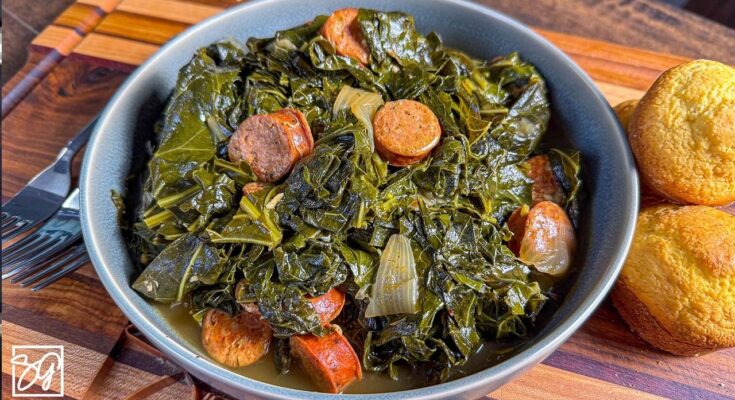Southern Greens Recipe: Nothing says comfort food quite like a pot of simmering Southern greens. Whether you’re from the South or just love soul food, this dish brings bold flavor, rich history, and a whole lot of love in every bite.
In this guide, we’ll walk you through everything from the ingredients list to the final serving suggestion. You’ll get a full breakdown of how to prep, season, and cook greens the authentic Southern way. Grab your pot—let’s get cooking.
What Are Southern Greens?
Southern greens are leafy vegetables—most commonly collard, mustard, or turnip greens—that are slow-cooked with savory ingredients like smoked meats, onions, garlic, and vinegar. They’re a staple in Southern cuisine, found on dinner tables from Alabama to Georgia and beyond. These greens are hearty, flavorful, and known for soaking up all the seasoning they’re simmered in, making them the perfect side dish (or main) for a soulful meal.
Unlike sautéed greens that are lightly cooked, Southern greens are stewed for a long time, allowing the leaves to become tender and infused with flavor. That “pot liquor” left at the bottom of the pot? It’s gold. Some even argue it’s the best part of the dish.
The Cultural Significance of Southern Greens
Southern greens aren’t just food—they’re history in a bowl. For generations, greens have been part of African American culinary traditions, passed down from enslaved ancestors who made use of what they had. They turned humble, foraged greens into deeply flavorful dishes with nothing but ingenuity and heart.
In Black Southern homes, greens are more than just a dish—they’re a tradition served at Sunday dinners, holiday feasts, and family reunions. They represent resilience, resourcefulness, and love passed from kitchen to kitchen.
Why You’ll Love This Recipe
This recipe is easy to follow but loaded with depth. Whether you’re a seasoned cook or a kitchen newbie, it’s accessible and rewarding. Here’s why it’s a winner:
- It’s comforting and filling.
- It works as a main or a side.
- The leftovers get better each day.
- It’s flexible—customize the greens, meats, and seasonings to your liking.
Let’s start by gathering the ingredients.
Ingredients You’ll Need
Fresh Greens – Collards, Mustards, Turnips
The backbone of this recipe is the greens themselves. You can choose one variety or mix a few. Each type offers a different taste and texture:
- Collard greens are sturdy and slightly bitter with a meaty texture.
- Mustard greens bring a peppery kick and a slightly spicy bite.
- Turnip greens are milder and more tender but still full of flavor.
Aim for about 2-3 bunches total, washed thoroughly to remove grit. If you buy pre-washed, bagged greens, still give them a rinse—they often still contain a little dirt or sand.
Smoked Meat – Ham Hocks, Turkey Legs, or Bacon
This is where the magic happens. Smoked meat brings that deep, rich, Southern flavor.
- Ham hocks are classic and offer a deep, porky richness.
- Smoked turkey legs or wings are great if you want a pork-free version.
- Bacon or fatback adds a delicious, crispy edge when sautéed first.
You only need 1-2 pieces, but don’t skimp here—it’s the soul of the dish.
Flavor Builders – Onion, Garlic, and Seasonings
No Southern greens are complete without aromatic vegetables and seasoning:
- 1 large yellow onion, chopped
- 3-5 cloves of garlic, minced
- Red pepper flakes or hot sauce, for heat
- Salt and black pepper, to taste
- A sprinkle of paprika or smoked paprika for color and flavor
These ingredients create the foundation that the greens and meat soak into.
Liquids – Broth, Vinegar, and a Touch of Sugar
You’ll need liquid to simmer the greens properly:
- 4–6 cups of chicken or vegetable broth (or water)
- 2 tablespoons of apple cider vinegar – gives it that tangy finish
- 1 teaspoon of sugar – just a pinch to balance the bitterness
This combo gives the greens their signature taste—savory, tangy, slightly sweet.
Optional Additions for Extra Kick
Want to take it up a notch? Try these add-ons:
- Hot sauce for more heat
- Crushed tomatoes for a more stew-like base
- Potatoes or okra for a veggie twist
- A splash of liquid smoke if you’re going meatless
Now that you’ve got everything, it’s time to cook these greens the Southern way.
Step-by-Step Guide to Making Southern Greens
Step 1 – Wash and Prep Your Greens
Start by cleaning your greens thoroughly. Use collard, mustard, or turnip greens, or a mix of all three for a true Southern medley. Rinse them several times in cold water to remove dirt and grit. Trim off any tough stems, then chop the leaves into bite-sized pieces. Set them aside in a colander to drain while you prepare the flavor base.
Step 2 – Prepare the Flavor Base
In a large pot or Dutch oven, heat 1–2 tablespoons of bacon grease or oil over medium heat. Add 1 chopped onion and 2 minced garlic cloves, sautéing until fragrant and soft. This base builds the soulful flavor that makes Southern greens so addictive.
Step 3 – Add Smoked Meat for That Rich Flavor
For that authentic Southern taste, add smoked turkey wings, ham hocks, or bacon to the pot. Let them brown slightly, releasing their smoky, salty goodness into the oil. This step transforms your greens from simple vegetables to pure comfort food.
Step 4 – Simmer Low and Slow
Add the chopped greens and enough chicken broth or water to cover them. Season with salt, pepper, and red pepper flakes for a little kick. Bring to a simmer, then reduce the heat to low. Cover and cook for 45–60 minutes, stirring occasionally, until the greens are tender and flavorful.
Step 5 – Taste, Adjust, and Serve with Style
Once the greens are tender, taste and adjust seasoning — add a dash of vinegar or hot sauce to brighten things up. Serve your Southern Greens with cornbread or rice, letting that savory “pot liquor” soak in.
Rich, smoky, and deeply satisfying, these greens capture the heart of Southern cooking — simple ingredients, slow love, and unforgettable flavor.
Tips and Tricks for Perfect Southern Greens
Choosing the Right Greens
Not all greens are created equal, and in the South, choosing the right type—or blend—can make or break your dish. Let’s break it down:
- Collard greens: These are the most traditional and widely used. They’re tough but hold up well to long cooking, absorbing flavors like a sponge. They’ve got a slightly bitter edge that mellows as they simmer.
- Mustard greens: These add a sharp, peppery bite. They’re a bit more delicate and cook faster, so they’re great for mixing with collards.
- Turnip greens: Milder and more tender, turnip greens have a subtle sweetness and pair wonderfully with the spicier mustard greens.
For the best results, mix 2–3 types of greens to add complexity and balance. This is how many Southern grandmothers do it—trust their wisdom.
Buy greens fresh if possible. Look for crisp, vibrant leaves without yellowing or wilting. If you’re short on time, pre-washed and chopped bagged greens are totally fine—just rinse them once more to be safe.
Getting the Texture Just Right
Texture is key. Southern greens shouldn’t be mushy, but they also shouldn’t be al dente like pasta. The goal is tender, silky, and juicy—each bite packed with flavor and just the right amount of chew.
Here are a few texture tips:
- Simmer low and slow. Don’t rush the process.
- Stir occasionally to distribute the seasoning and meat evenly.
- Don’t overfill the pot—give the greens space to cook down.
The longer they simmer, the more tender they become. Most Southern cooks agree that 90 minutes to 2 hours is the sweet spot for texture and taste.
Balancing Smoky, Tangy, and Savory Notes
Southern greens are all about balance—deep smokiness from the meat, tang from vinegar, sweetness from sugar, and a punch of savory herbs and spices.
To nail that perfect balance:
- Use smoked meat generously, but not overpoweringly.
- Add apple cider vinegar during cooking and a splash at the end for brightness.
- Don’t be afraid to taste and tweak—it’s your pot of greens, and no one knows your flavor preferences better than you.
Trust your taste buds. That’s what Southern cooking is all about.
What to Serve With Southern Greens
Classic Pairings – Cornbread, Fried Chicken, and More
Southern greens are versatile. They can be a side dish, but they also shine as a star player. Here are some tried-and-true pairings:
- Cornbread: This is the classic companion. It’s perfect for soaking up the pot liquor. Try sweet cornbread if your greens are spicy, or a more savory version if you’ve added sugar to your greens.
- Fried chicken: Crispy, juicy, and golden-brown fried chicken sits beautifully next to a scoop of greens.
- Pork chops or ribs: Smoked or grilled pork enhances the flavor harmony.
- Macaroni and cheese: Creamy mac balances out the tang and bitterness of the greens.
- Rice or grits: These can serve as a neutral base for the saucy greens.
Looking for a vegetarian Southern meal? Pair your greens with black-eyed peas, okra stew, or sweet potatoes for a plant-based soul food feast.
Southern Meal Planning Made Simple
To round out a perfect Southern plate:
- Choose one protein (fried chicken, pork, or beans).
- Add your greens.
- Throw in a starch (cornbread, mac, rice).
- Finish with a sweet treat (peach cobbler or banana pudding).
This formula never fails, whether you’re cooking for a crowd or just treating yourself to a comforting dinner.
How to Store and Reheat Leftovers
Best Practices for Refrigerating and Freezing
Southern greens store well, and many argue they taste even better the next day. Here’s how to keep them fresh:
- Refrigerate: Once cooled, transfer greens and their broth to an airtight container. They’ll keep in the fridge for up to 5 days.
- Freeze: For longer storage, freeze in zip-top bags or freezer-safe containers. Greens can last up to 3 months in the freezer.
Make sure to include some pot liquor in the container—that broth is essential for reheating and maintaining flavor.
How to Reheat Without Losing Flavor
Reheating is easy, but here’s how to keep them tasting just as good:
- Stovetop: Add greens and pot liquor to a saucepan. Heat over medium-low, stirring occasionally until warmed through.
- Microwave: Use a microwave-safe bowl with a splash of broth. Cover loosely and heat in 1-minute intervals, stirring in between.
If the greens seem a bit dry, add a little broth or water. You can even toss in a splash of vinegar or hot sauce to revive the flavors.
Pro tip: Avoid reheating more than once. Only heat what you plan to eat to preserve the texture and taste.
Common Mistakes to Avoid
Overcooking or Undercooking Greens
Southern greens are all about slow-cooked perfection, but you can still miss the mark. Here’s how:
- Undercooking: Leaves them tough and grassy-tasting. Always aim for at least 45 minutes, but ideally 90+ minutes of simmer time.
- Overcooking: While some love them “melted,” if they’re mushy and gray, you’ve gone too far. Keep an eye on the texture and stop cooking when they’re silky and tender.
Start checking at the 45-minute mark and taste every 15 minutes from there. That’s how the pros do it.
Skimping on the Flavor Base
Some folks think greens are bland, but that’s only if you skip the flavor foundation. Don’t make that mistake.
- Always start with onions, garlic, and seasonings.
- Don’t forget the vinegar, broth, and sugar—they balance everything out.
- And yes, the smoked meat or a great meat substitute is essential for that deep Southern flavor.
Skipping these steps means you’ll end up with greens that are flat, bitter, or boring. Layer your flavors like a seasoned Southern chef.
Nutritional Benefits of Southern Greens
Packed with Vitamins, Minerals, and Fiber
Greens don’t just taste good—they’re packed with nutrients. Here’s what makes them a health win:
- Vitamins A, C, and K: These are essential for eye health, immune function, and blood clotting.
- Calcium and Iron: Key minerals for strong bones and healthy blood.
- Fiber: Greens are full of it, which supports digestion and heart health.
And the best part? Even after a long simmer, most of these nutrients are retained in the pot liquor—so don’t skip it!
Making the Dish Healthier Without Losing Flavor
Want to make your greens a bit lighter?
- Use smoked turkey instead of pork for a lower-fat option.
- Cut back on salt and add more herbs and spices for flavor.
- Skip the added sugar or use a natural sweetener like honey or maple syrup.
You can even go fully vegetarian or vegan. Use liquid smoke, mushrooms, or smoked paprika to mimic that meaty depth.
With a few tweaks, Southern greens can be both soulful and healthful—without compromising on flavor.
Variations of Southern Greens Across the South
Georgia Style vs. Louisiana Style
Southern greens may have one soul, but they wear many flavors depending on where you are in the South. Here’s how the styles differ:
- Georgia Style: Known for a slightly sweeter, milder profile. Cooks in Georgia often mix collards with turnip greens and add a little more sugar and vinegar. You might even find a hint of hot sauce, but the flavor leans more comforting than spicy.
- Louisiana Style: Down in Cajun country, greens come with a kick. Think bold spices, hot peppers, and lots of garlic. Some Louisiana versions even add Andouille sausage or spicy smoked meats. You’ll get heat, depth, and rich, dark pot liquor that’s almost like a stew.
Each style is a love letter to local tradition, and both are delicious in their own right.
How Different Families Put Their Spin on It
No two pots of greens taste exactly the same. That’s because every Southern cook adds their personal flair. Some popular family traditions include:
- Adding boiled eggs: Sliced on top of greens for presentation and protein.
- Sweetening with molasses or brown sugar: For an earthy sweetness.
- Throwing in hot peppers: Whole or chopped, for a background burn.
- Using smoked neck bones or fatback: Lesser-known cuts that pack flavor.
The truth is, Southern greens are as diverse as the families that make them. Whether you keep it traditional or add your spin, there’s no wrong way—just your way.
FAQs about Southern Greens Recipe
1. Can I use bagged greens instead of fresh?
Yes, you absolutely can. Bagged greens are a time-saver and usually pre-washed, but it’s still a good idea to rinse them again. Just make sure they’re free from yellow or slimy pieces. And don’t worry—they cook up just as delicious as fresh.
2. What’s the best meat substitute for a vegetarian version?
To make it vegetarian or vegan, skip the smoked meat and use liquid smoke, smoked paprika, or mushrooms to create that deep umami flavor. You can also use vegetable broth and olive oil for the base. A dash of soy sauce or tamari adds a savory punch too.
3. How do I cut the bitterness of some greens?
Bitter greens like collards or mustard can be tamed with a few tricks:
- Add a touch of sugar or honey during cooking.
- Splash in some apple cider vinegar for balance.
- Cook them longer—bitterness often mellows the more they simmer.
Don’t forget the broth, garlic, and meat (or substitute). These help mask and balance bitterness naturally.
4. Can I make Southern greens in a slow cooker or Instant Pot?
Yes! Both work wonderfully:
- Slow Cooker: Add all your ingredients and cook on low for 6–8 hours.
- Instant Pot: Sauté your onions and meat first, then add greens and liquid. Pressure cook on high for 20–30 minutes with a natural release.
These methods save time and effort without sacrificing that rich, cooked-all-day flavor.
5. How long do cooked greens last in the fridge?
Cooked Southern greens last about 4–5 days in the fridge when stored in an airtight container. You can also freeze them for up to 3 months. When reheating, always add a splash of broth to revive the flavors.
Conclusion
Southern greens are more than just a side dish—they’re a celebration of history, family, and soul food heritage. Every pot tells a story: of resourcefulness, flavor, and love simmered together over generations. Whether you’re whipping up a big Sunday dinner or just craving something hearty and wholesome, Southern greens deliver comfort with every bite.
From prepping the greens to mastering the flavor base and slow-cooking them to perfection, this guide gives you everything you need to bring authentic Southern greens to your table. Remember, the secret ingredient isn’t just the smoked meat or the vinegar—it’s the time, care, and heart you put into it.
So go ahead. Get those greens simmering, invite the family over, and taste a true Southern classic that never goes out of style.


